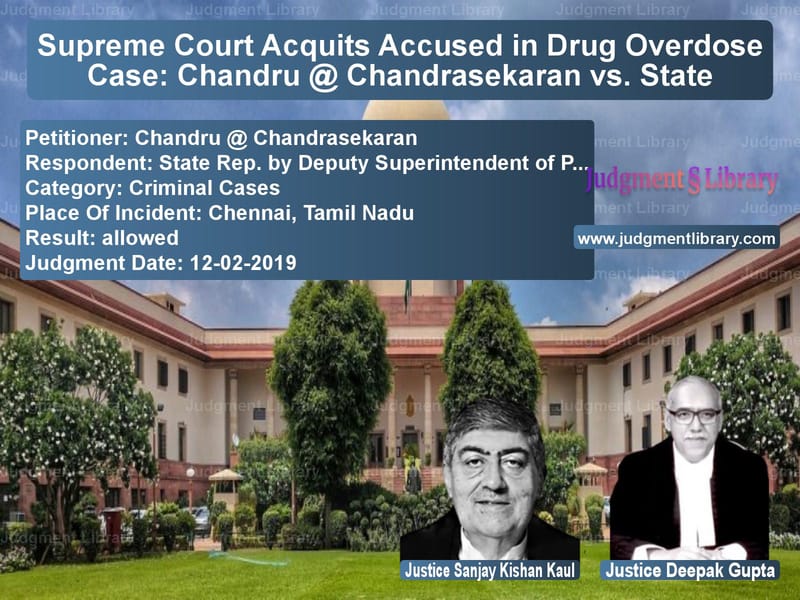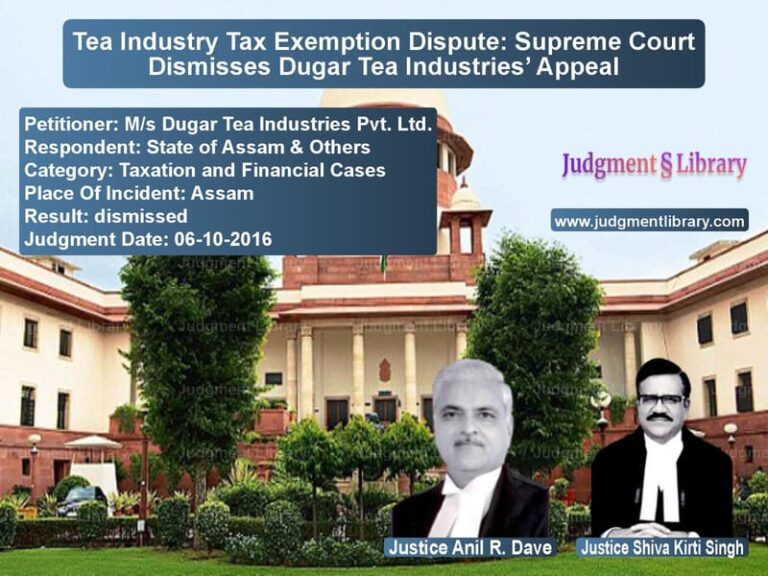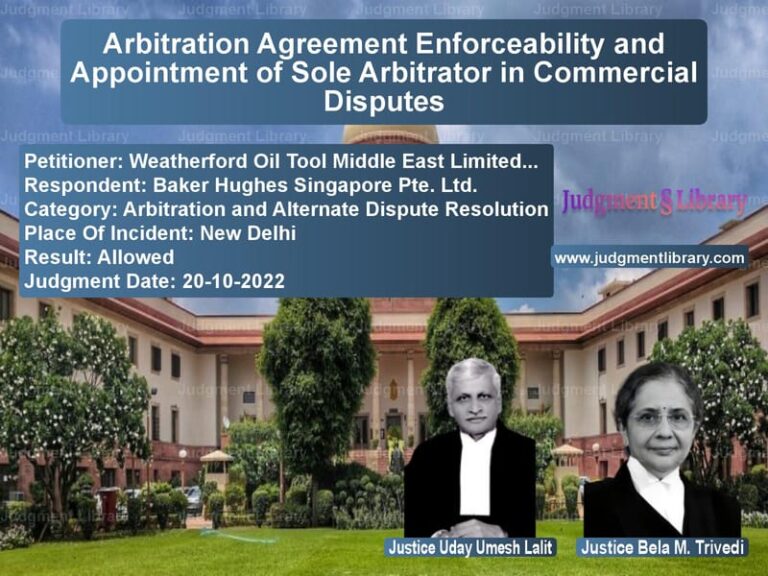Supreme Court Acquits Accused in Drug Overdose Case: Chandru @ Chandrasekaran vs. State
The Supreme Court of India, in its ruling on Chandru @ Chandrasekaran vs. State, overturned the conviction of two accused who were charged with the murder of their friend by drug overdose. The case was primarily based on circumstantial evidence, and the judgment highlighted critical legal principles regarding circumstantial evidence, last-seen theory, and medical inconsistencies.
Background of the Case
The case revolves around the death of Arun, who was found dead in Room No. 203 of Meena Guest House, Chennai, on the morning of October 31, 2004. Arun had traveled to Chennai with his friends Siva @ Sivaprakash (Accused No. 1) and Chandru @ Chandrasekaran (Accused No. 2) on October 30, 2004. They checked into the guest house at around 9:00 p.m.
At around 9:30 p.m., another individual, Venkatesh @ Venki, arrived at the room and allegedly administered a 4 ml injection of Tidijesic (a narcotic drug) into Arun’s left wrist. Venki also injected himself with 2 ml of the same drug before leaving the guest house. The next morning, when Arun did not wake up, the accused called Venki, who later informed Arun’s uncle. When the hotel staff discovered that Arun was unresponsive, the police were alerted.
Initial Investigation and Prosecution
Following Arun’s death, a case was registered under Crime No. 1150 of 2004. The initial investigation focused on Venki as the primary suspect. The police conducted polygraph, brain-mapping, and narcoanalysis tests on the three main suspects—Venki, Siva, and Chandru. While Siva and Chandru cleared the tests, Venki’s responses were found to be deceptive.
In 2006, the deceased’s father filed a petition in the Madras High Court requesting a transfer of the investigation to the Central Bureau of Investigation (CBI). However, the High Court rejected this request in 2008. Meanwhile, in 2008, the CB-CID filed a charge-sheet under Section 304 Part II of IPC (culpable homicide not amounting to murder) against Venki, who died before the trial could begin.
Private Complaint and New Charges
After Venki’s death, the deceased’s uncle filed a private complaint in the trial court, alleging that Siva and Chandru were responsible for injecting Arun with a lethal dose of drugs. The Metropolitan Magistrate recorded statements of several witnesses and took cognizance of the offense under Section 302 IPC (murder). The case was committed to the Sessions Court, and the accused were convicted under Sections 302 and 120B IPC (criminal conspiracy) and sentenced to life imprisonment.
Appeal and Supreme Court Proceedings
The accused challenged their conviction in the High Court, which upheld the trial court’s decision. The case was then taken to the Supreme Court, where the appellants argued that the conviction was based purely on circumstantial evidence without any direct proof of their involvement.
Supreme Court’s Observations
The Supreme Court carefully examined the evidence and ruled that the prosecution failed to establish the guilt of the accused beyond reasonable doubt. The court highlighted several key aspects:
1. Lack of Direct Evidence
The court noted that there were no eyewitnesses to the alleged murder. The case was entirely based on circumstantial evidence, which needed to form an unbroken chain leading to only one conclusion—guilt of the accused. The prosecution failed to prove this conclusively.
2. Medical Evidence and Inconsistencies
The post-mortem report confirmed that Arun had died due to an overdose of Tidijesic. However, the forensic analysis revealed that the drug level in Arun’s blood was equivalent to 40 ml of Tidijesic, whereas the known administered dose was only 4 ml.
Key inconsistencies noted by the Supreme Court:
- The post-mortem report did not establish the exact time of death, making it difficult to determine when the additional drug was administered.
- The prosecution failed to explain how Arun obtained the remaining 36 ml of Tidijesic.
- There was no proof that the accused had access to the additional dose of the drug.
3. Failure to Prove Motive
The prosecution argued that Siva was jealous because Arun was talking to R (PW-10), a girl whom Siva liked. However, R’s testimony did not support this claim, and there was no evidence of a dispute between Siva and Arun.
4. Last Seen Together Theory
The court acknowledged that the accused were the last known individuals with Arun before his death. However, it pointed out that being last seen with a deceased person does not automatically prove guilt. The prosecution failed to establish any actions by the accused that directly caused Arun’s death.
5. Delay in Filing a Private Complaint
The court was skeptical about the delayed filing of the private complaint, which came four years after Arun’s death. The Supreme Court found this delay suspicious and noted that no new evidence had emerged to justify the delay.
Final Verdict
The Supreme Court acquitted both accused and set aside the judgments of the High Court and trial court. It ruled:
“The prosecution has failed to prove beyond reasonable doubt that the accused injected the deceased with an overdose of drugs. There is no evidence linking them to the crime. Hence, we allow the appeal and direct the immediate release of the accused unless required in any other case.”
Key Takeaways from the Judgment
- Burden of Proof in Circumstantial Cases: The ruling reinforces that circumstantial evidence must form a complete chain leading to only one possible conclusion—guilt of the accused.
- Medical Evidence Must Be Conclusive: Courts rely on forensic analysis, but inconsistencies can weaken the prosecution’s case.
- Last Seen Together is Not Enough: Being with a deceased person before their death does not establish guilt unless corroborated by strong evidence.
- Delays in Filing Complaints Weaken Cases: Filing charges years after an incident, without new evidence, raises questions about credibility.
Conclusion
The Supreme Court’s decision in Chandru @ Chandrasekaran vs. State highlights the importance of a thorough investigation and strong evidence in securing convictions. This case serves as a reminder that courts must uphold the principle of innocent until proven guilty, especially in cases relying solely on circumstantial evidence.
Petitioner Name: Chandru @ Chandrasekaran.Respondent Name: State Rep. by Deputy Superintendent of Police CB-CID.Judgment By: Justice Sanjay Kishan Kaul, Justice Deepak Gupta.Place Of Incident: Chennai, Tamil Nadu.Judgment Date: 12-02-2019.
Don’t miss out on the full details! Download the complete judgment in PDF format below and gain valuable insights instantly!
Download Judgment: Chandru @ Chandrasek vs State Rep. by Deputy Supreme Court of India Judgment Dated 12-02-2019.pdf
Direct Downlaod Judgment: Direct downlaod this Judgment
See all petitions in Bail and Anticipatory Bail
See all petitions in Juvenile Justice
See all petitions in Drug Possession Cases
See all petitions in Judgment by Sanjay Kishan Kaul
See all petitions in Judgment by Deepak Gupta
See all petitions in allowed
See all petitions in supreme court of India judgments February 2019
See all petitions in 2019 judgments
See all posts in Criminal Cases Category
See all allowed petitions in Criminal Cases Category
See all Dismissed petitions in Criminal Cases Category
See all partially allowed petitions in Criminal Cases Category







